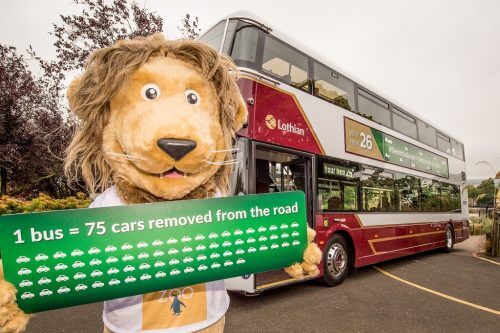
Operator aims to have entire fleet operating on St John’s Road reaching Euro 6 standards by the end of next year
Lothian Buses has launched a fleet of 30 new, low emission buses serving one of Edinburgh’s busiest roads, representing an investment of over £7m.
Presented to the city in a parade from Princes Street to Edinburgh Zoo, the new Euro 6 Wrightbus Gemini 3-bodied Volvo double-deckers will operate on Service 26. The service connects communities from the west of the city to East Lothian, travelling along St John’s Road in Corstorphine, which is one of Edinburgh’s air quality management zones.
Once named as the ‘most polluted road in Scotland’, Lothian Buses expects to convert its final service along the corridor to Euro 6 by the end of 2018. With this latest investment, all its buses on the key artery into the city will meet a minimum of Euro 5 emission standards.
The engines on the new buses will have much lower CO2 emissions, with the combined reductions in the new fleet equivalent to that of 164 cars per year.
The custom-built specification of the new vehicles includes USB charging points, high-back seats, increased glazing for visibility and media screens with next-stop audio and visual announcements.
Over 7.5m journeys were taken on Service 26 throughout 2016, an average of 150,000 journeys per week.
By the end of 2017, Lothian Buses expects 76% of its fleet to be at Euro 5 emission standards or above. The company plans to introduce 86 new vehicles this year in an investment worth £20.9m.
Richard Hall, Managing Director of Lothian Buses, said: “We fully support the City of Edinburgh Council’s and the Scottish Government’s strategies to improve local air quality.
“St John’s Road has always been a main artery within the city that we had earmarked for improvement and investment.
“The introduction of 30 new low emission buses to this route, combined with our on-going fleet replacement strategy BUS2020, ensures that we as a business are doing our part to improve air quality across the city.
“Buses are the lifeblood of the city and economy, transporting thousands of customers every day.”
Cllr Lesley Macinnes, Transport Convenor for the City of Edinburgh Council, said: “We welcome this investment by Lothian, which will significantly impact emissions in areas of poorer air quality across the city as part of a continued effort to convert to cleaner, greener vehicles.
“As a council we are committed to improving air quality and reducing CO2 emissions via a range of measures, but it is only with the support of companies like Lothian that we will be able to achieve this.”
Emilia Hanna, Air Pollution Campaigner at Friends of the Earth Scotland, added: “‘We welcome Lothian’s launch of a cleaner 26 route along the St John’s Rd corridor, which is Edinburgh’s most polluted street. Air pollution is still a public health crisis in Scotland, responsible for over 2,500 early deaths each year. Buses are a key part of the solution to air pollution and are essential for the majority of Edinburgh residents who do not travel by car.
“One full double-decker bus can hold the equivalent number of passengers as 75 cars can, so buses are a clear winner when it comes to tackling congestion and toxic air pollution, especially when they offer a clean and comfortable experience.”

